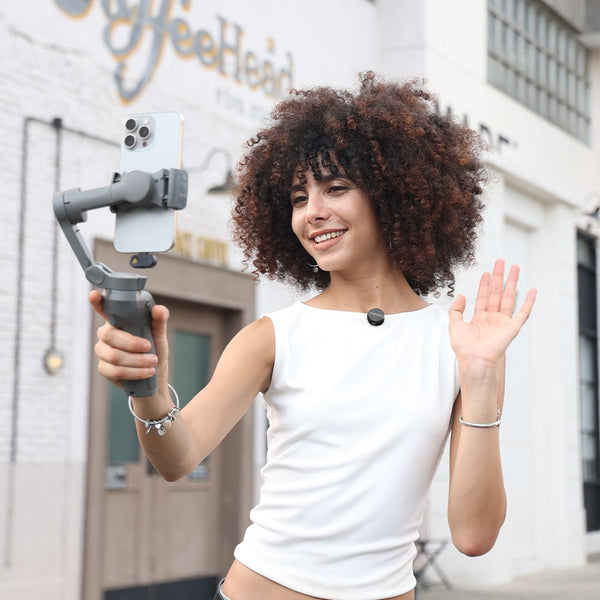Choosing between a mic with a desktop stand or a boom arm really depends on how you plan to set up your recording space. In short, it depends on what your setup requires.
When it comes to streaming, podcasting, or recording vocals, microphone placement plays a crucial role in achieving professional sound quality. Two of the most common mounting options are mic stands, including desktop varieties, and boom arms. Each has its pros and cons, and choosing between the two can influence not only how you sound but also how comfortably you work.
So, which is better for streaming: a mic on a desktop stand or one mounted on a boom arm? While both can deliver excellent audio results, factors like space, comfort, sound isolation, and recording habits can determine the better fit for your setup.
Mic with Desktop Stand vs. Boom Arm: Pros and Cons
A desktop mic stand offers simplicity and portability. It sits directly on your desk and is ideal for quick setups or mobile recording. However, it’s more susceptible to picking up desk vibrations and may block access to your keyboard or monitor.
A boom arm, on the other hand, clamps to the side of your desk and suspends the microphone in the air. It offers more flexibility, better noise isolation, and helps maintain consistent mic positioning. The trade-off? Boom arms can be bulkier and cost a little bit more.
Which setup gives better sound quality: boom arm or desktop mic stand?
Sound quality depends heavily on mic placement and isolation. Boom arms tend to have an edge because they isolate the mic from desk bumps and allow for precise, stable positioning. With a boom arm, it’s easier to maintain a consistent distance and angle between your mouth and the mic, improving vocal clarity—especially if you're using a streaming microphone for live or recorded sessions.
What are the main differences between a mic with a boom arm vs. a stand?
-
Mobility
Boom arms are more adjustable and can swing in/out of place easily.
-
Noise isolation
Boom arms reduce desk vibrations and surface noise.
-
Space usage
Desktop mic stands take up desk space, while boom arms free up your surface.
-
Cost
Desktop mic stands are generally more affordable, making them a great option for those searching for a computer mic stand on a budget.
What should I look for in a high-quality desktop stand or boom arm?
A sturdy base, adjustable height, and solid materials are essential for desktop mic stands. For boom arms, look for smooth articulation, strong clamping mechanisms, and compatibility with different mic weights. A high-quality shock mount and pop filter can further improve results for both setups. If you're searching online for the best mic stand, prioritize build quality and user reviews for long-term value.
Is a desktop stand good enough for professional voice recording?
Yes, especially when paired with a pop filter and shock mount. For controlled environments and stationary setups, desktop mic stands can deliver professional-grade recordings. However, they may not be ideal for dynamic or multi-monitor setups where space is limited. If you’re trying to find a mic stand asap, go type a quick search on Google and use keywords like: “mic stand near me” make sure that your choice supports the weight and thread type of your microphone. You can also simply visit the official Maono website for better deals (especially if you're a new user/buyer).
Why do most streamers and podcasters use boom arms?
Boom arms offer several advantages that cater to streaming and podcasting needs:
-
Better mic placement and consistency
-
Hands-free access to keyboards, notes, and equipment
-
Reduced risk of knocking the mic over
-
Easier cable management
Are boom arms really worth the extra cost?
For creators serious about sound quality and workflow efficiency, yes. While desktop mic stands are cheaper, boom arms offer superior ergonomics and reduce unwanted noise. If you stream or record frequently using a streaming microphone, the investment is justified.
Practical Use & Setup of Desktop Stand and Boom Arm:
Which one is easier to set up for beginners?
Desktop mic stands are easier to set up—just place them on your desk, attach the mic, and you’re ready to record. Boom arms require clamping, adjusting tension, and cable routing, which might take extra time initially.
Does a boom arm take up more space than a desktop stand?
Not necessarily. Boom arms actually save desk surface space by clamping to the edge. However, they do require vertical and horizontal clearance, so if your workspace is tight, it may need strategic placement.
Will a desktop mic stand pick up more vibrations or desk noise?
Yes. Desktop mic stands are more prone to picking up bumps, typing, and other vibrations unless paired with a high-quality shock mount. A boom arm naturally avoids contact with the desk surface, minimizing these issues.
How do you position a boom arm mic properly for singing or speaking?
Position the boom arm so the mic hangs upside down or horizontally in front of your mouth, about 6–8 inches away. Use a pop filter to reduce plosives, and ensure the mic angle is slightly tilted to avoid harsh breathing sounds.
Can I use a boom arm if I have a small desk or limited space?

Yes, as long as there’s room to clamp the boom arm to the side or back of the desk. The Maono BA92 boom arm, for example, has a compact yet sturdy design that fits tight spaces while offering full flexibility. It’s one of the best mic stand options available for creators with limited workspace.
More FAQs about Boom Arm and Desktop Mic Stand:
Which one is more comfortable to use for long recording sessions?
Boom arms tend to be more ergonomic. They allow for adjustable mic height and distance without crowding your workspace, which is ideal for extended sessions.
Does a boom arm help reduce mouth noises or plosives?
Indirectly, yes. Boom arms help maintain consistent positioning, which means you can optimize your mic angle and distance to reduce harsh noises. Pair it with a pop filter for best results.
Can a desktop mic stand block your keyboard or screen?

It can, depending on your setup. A low-profile stand or a side-positioned boom arm can help avoid obstructions. The Maono Microphone Desktop Stand is compact and adjustable, making it a great computer mic stand for tighter desk setups.
Is it easier to get consistent mic positioning with a boom arm?
Yes. Boom arms allow you to "set and forget" the mic placement. Once positioned correctly, it stays in place, ensuring consistent sound quality every time. The Maono BA92 Boom Arm offers flexible rotation, adjustable height, and durable construction—perfect for streamers and vocalists.
Will a boom arm help reduce background noise?
While it doesn’t eliminate ambient noise, a boom arm helps by isolating the mic from desk vibrations and positioning it closer to your mouth, allowing for lower input gain and less room noise.
Conclusion
Both desktop mic stands and boom arms have their place in the streaming and vocal recording world. If you're just getting started, a desktop stand is an easy, budget-friendly option. It’s portable and ideal for simple setups.
However, if you’re serious about streaming or podcasting, a boom arm offers clear advantages in comfort, consistency, and sound quality. It keeps your mic off the desk, reduces noise interference, and enhances your workflow.
For the best of both worlds, choose trusted accessories like the Maono BA92 Boom Arm or Maono Desktop Stand—designed with creators in mind. Whether you’re browsing online or searching for a mic stand near me, these tools help take your audio quality to the next level.
Ultimately, the best mic stand for you depends on your goals, space, and how often you record. Either way, investing in the right mic stands is a step toward clearer, more professional audio content.
Related Article:
Mic Stands Explained: Types, Features & Tips for Choosing the Best



